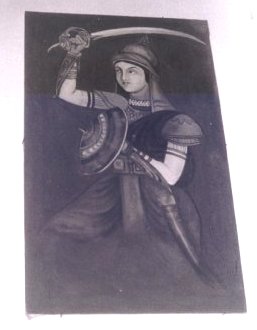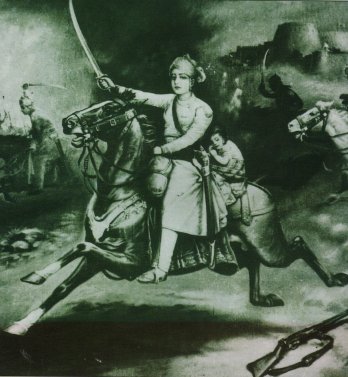Queen Lakshmibai of Jhansi
by Dr. Jyotsna Kamat
First Online: July 13, 2007
Last Updated: December 07, 2024
Rani Lakshmibai of Jhansi (1835 - 1858)
It is appropriate to remember the young brave queen of Jhansi on the occasion of 150th year of
First War of Independence which is also called "Sepoy
Mutiny". When we learn about courage and fearless fighting of Lakshmibai who died fighting the British on the battlefield, it was not a mere "mutiny". It was an honest attempt to resist misrule and injustice of the British, who were bent on expanding their colonial interests in India, by harming the native rules and the ruled alike.
Lakshmibai was born at Banaras of Moropant Tembe and Bhagirathibai. She was married to Gangadhar Rao Navalkar, the ruler of Jhansi, a small state created by the Peshwas. Moropant was a prot�g� of Peshwa Baji Rao II and accompanied him even after the Peshwa lost his kingdom. A liberal father, he had provided, proper education & martial training to his daughter. Gangadhar Rao died in 1853 CE without Issue. Lakshmibai was not allowed to adopt a successor by the Governor General. The idea was to
annex such regions of childless rulers to British Empire, under their infamous `Doctrine of Lapse'.
The young queen engaged a British Lawyer John Lang for appeal to the Directors of
The East India Company in England, (who ruled India on behalf of the British Queen) against the decision.
The appeal failed and Jhansi was annexed to British administration. The
Queen was given a humiliating monthly pension of five thousand rupees, which was too small even to maintain her small band of followers. The British thought that in all probability she may leave Jhansi and go to her father's shelter. But the courageous queen decided not to leave her domain at any cost, and got ready to face the consequences.
The rebellion against British by the sepoys broke out at Meerut and Delhi on the 10th of May 1857. Gradually it spread to other parts of northern India. Jhansi claimed authority of the queen Lakshmibai on 9th of June. From that date till the 4th of April 1858, Lakshmibai defended her fort against Sir Hugh Rose. But realizing that her position was becoming weak by hours, she made a adventurous escape from Jhansi fort through the cordon of British troops, on horseback and went to Kalpi and joined the indomitable Tantia Topi
(a.k.a Tatia Topi) who had taken on the British relentlessly. They together started recruiting soldiers from Oudh and Doab. The Rajputs and Brahmins, comprised infantry; Rohillas and Muslims formed cavalry. The
Queen personally lead the newly formed battalion. She used to dress in military uniform of crimson jacket, crimson trousers and a white turban. It was impossible to tell her
gender.
kamat.com/Kamat's Potpourri
Sculpture of Rani Lakshmibai of Jhansi
But General Rose captured Kalpi, from which Lakshmibai's troops were fighting the British. The Queen and Tantia Topi fled to the jungle. General Rose thinking that the rebellion was over, left and issued orders to disband his troops.
At this juncture, the Rani and Tantia Topi astounded the British by capturing the fort of Gwalior which had good store of arms and ammunition on the 4th of June 1858. It was the hottest part of summer season. The ruler of Gwalior fled and all his troops joined the Rani of Jhansi! Now the rebel army had a equipped contingent, well trained in the British way of warfare.
The ruler of Gwalior was prot�g� of the British and General Rose, reached Morar on the border of Gwalior. Stores and ammunitions were seized with the help of his huge army, on 16th of June. Next day, General Rose crossed Gwalior and met Rani's cavalry, which she was personally leading. The old fashioned muzzle-loaders and clumsy swords of Lakshmibai's troops were no match against well-equipped British army. In the battle that ensued, the Rani fought bravely but was killed. Thus died the young and brave queen far away from her beloved Jhansi overpowered by a superior force.
Rani Lakshmibai is described as a very pretty lady with round face, very delicately shaped nose and bright eyes. She was of medium height and neither stout nor lean. Her portrait with sword and shield shows a determined and pensive expression.
The Bravery of Lakshmibai in Indian Art
The bravery of Lakshmibai has inspired many ballads, legends, paintings and sculptures. Here's a collection of pictures from Kamat Picture Archive
Rashrothana Parishad/Kamat's Potpourri
Laxmibai, the Queen of Jhansi
Indian Queen dressed for battle to defend her kingdom against the British
K.L. Kamat/Kamat's Potpourri
Queen of Jhansi, Laxmibai
Painting by Rudrakumar Jha
K.L. Kamat/Kamat's Potpourri
Indian Stamp Honoring Laxmibai of Jhansi
Detail from a Indian postal stamp
kamat.com/Kamat's Potpourri
Queen of Jhansi at Battlefield
kamat.com/Kamat's Potpourri
Queen of Jhansi by Mahadev Vishvanath Dhurandhar, 1927
(Picture Courtesy: Annette Biggs)
See Also:
-
The Sepoy Mutiny -- The ''Sepoy Mutiny'' is a remarkable event in Indian history, marking the end of the Mogul empire and sealing India's fate as a British colony.
-
Old-timey Education -- Dr. Jyotsna Kamat hosts an amusing online exhibition of historical artifacts on education in India through the centuries


